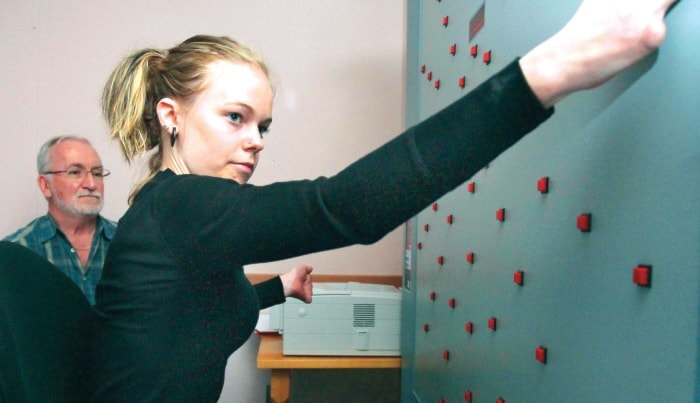A tool used to strengthen an athlete’s reflexes has found its way into the world of occupational therapy at the Centennial Centre for Mental Health and Brain Injury.
Occupational therapist Gary Rowland has been using the Dynavision 2000 for the last five years and it has shown improvement in a person’s hand/eye co-ordination, as well as helping a patient who has suffered brain injury in their lives.
The Dynavision uses lights on a grid and an athlete or patient is required to touch the flashing lights as quickly as possible.
“The idea is that when the lights come on, the computer generated a time from when the light lights up until the time that it is pushed by contact,” Rowland explained.
The Dynavision 2000 helps a person’s reaction time and also develops strength in their peripheral vision. The machine is widely used in sports with hockey goalies, Nascar drivers and other athletes but occupational rehabilitation professionals have found there is also a relationship with the program and being able to drive again.
A patient at the centre, Stephanie Wierenga, suffered brain damage and the loss of her legs and fingers in a car collision in November 2010 and is working with the Dynavision 2000 to develop her hand/eye co-ordination. She wants to be able to drive again and Rowland feels it will help her get to that point.
The Dynavision 2000 also has a small screen in the middle of its array of lights and a number can also be displayed for a person to call out while they try to hit the lights. On the board there are four quadrants and lights can be activated across them or in specific areas. For Wierenga, the lights are on mainly on the lower portion as she sits in a wheelchair as well and cannot reach the top of it.
It is a flexible enough machine that Rowland has been able to help people with issues of hemianopsia, where a portion of a person’s eyesight is blocked in either one or both eyes. Patients have used the machine to train themselves to adjust for the blind spots.
The machine tests a person’s ability to react to the lights and it can help identify blind spots in a person.
“We would look for differences in the quadrants or in the visual field,” explained Rowland.
There multiple ways to use the Dynavision 2000 and if Rowland wants to diagnose a person’s issues, he can make sure the lights stay on for only one second.
The challenge Wierenga faced when using the machine was on her left side, she has less sensitivity in her left hand and Rowland uses the machine to help her adjust to those issues. “I don’t see that Stephanie has any visual field cuts but if she’s going to be going back to driving, she needs to have hand controls,” he said. “So with Stephanie what we have is a difference in how well she uses her right side versus her left side. I’m using this primarily to work on accurate speeded, eye/hand co-ordination with her left hand.”
Results from the test identified where Wierenga has the most difficulty and Rowland uses those numbers to guide her in rehabilitation. Wierenga’s therapy is continuous but she can now bath and cook for herself. Driving is another important part of her life, said Rowland. Wierenga has just started to use the Dynavision 2000 so it is too early to say how it has helped her but Rowland feels there are benefits to using it.
“We can use it with visual deficits…In Stephanie’s case we want to really promote the accurate movement of this (left) arm,” he explained.
Wierenga will have to go through an evaluation if she is able to proceed and drive and she might be driving with her right or left arm using an assisted device in the vehicle. Wierenga would like to move on with her life after the accident and this is one of the ways to get her there. “Life goes on.”
CEO and founder of Dynavision, Phil Jones, used to build the machines himself but demand for them has grown large enough that he has had to move his business to the United States. Jones, from Toronto, Ont., played in the Canadian Football League in the 1980s and he wanted a way to increase reaction times in the sport but found other uses for it.
“It was immediately recognized and accepted in the world of rehab,” stated Jones.
The machine also helps users learn how to scan their field of vision and adjust for deficiencies. It has grown to such a degree it is in that all the Veteran’s Affairs hospitals in the United States and in more than 800 hospitals in North America.
Jones feels one of the greatest benefits of Dynavision’s machines is how well people are involved with it.
“Doctors like it and patients like it because they get a score,” he said. “It’s really the mental side of high performance.”
The Dynavision 2000 has only one colour to its lights but a new one, the D2, has multiple colours.
